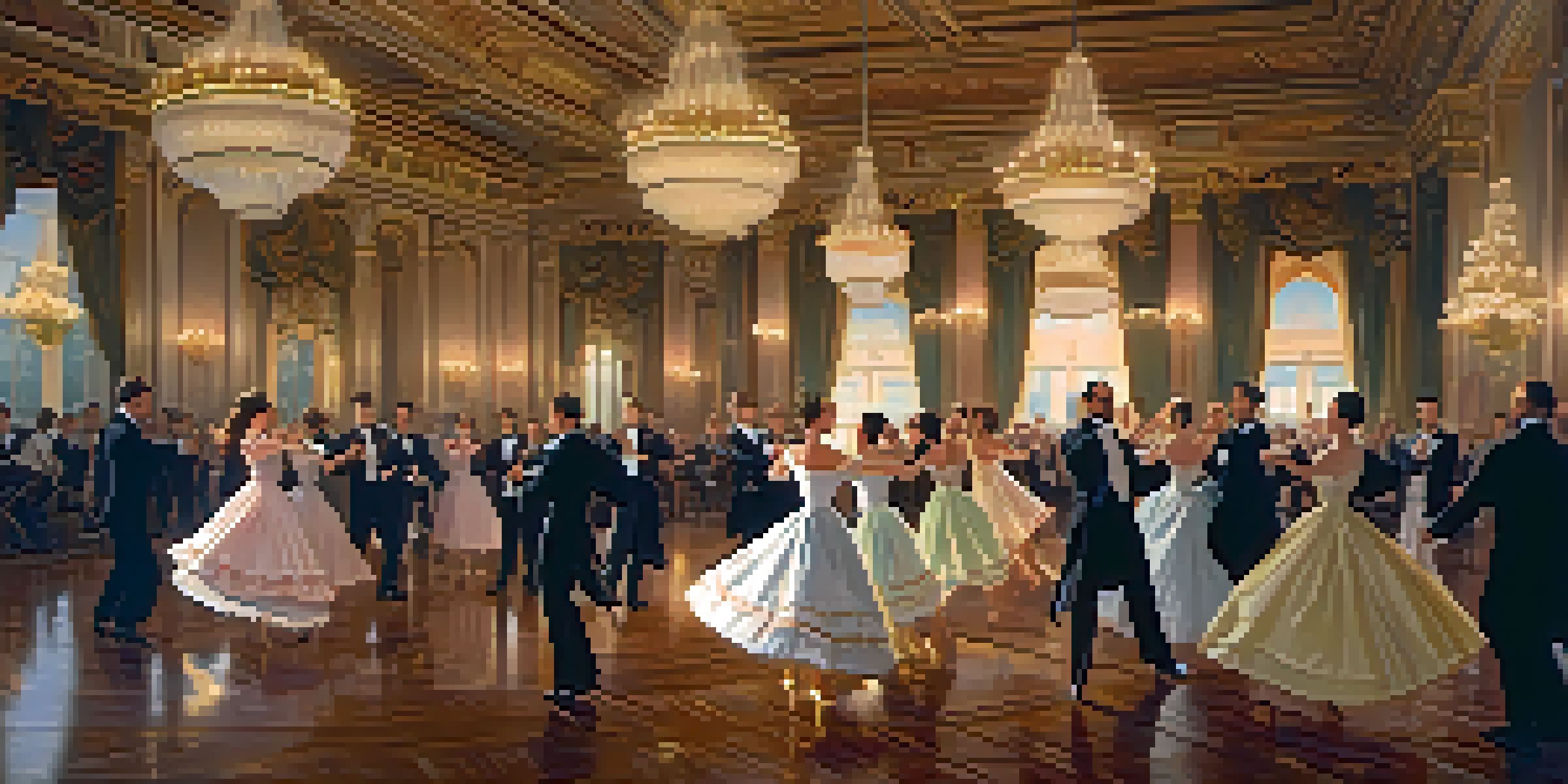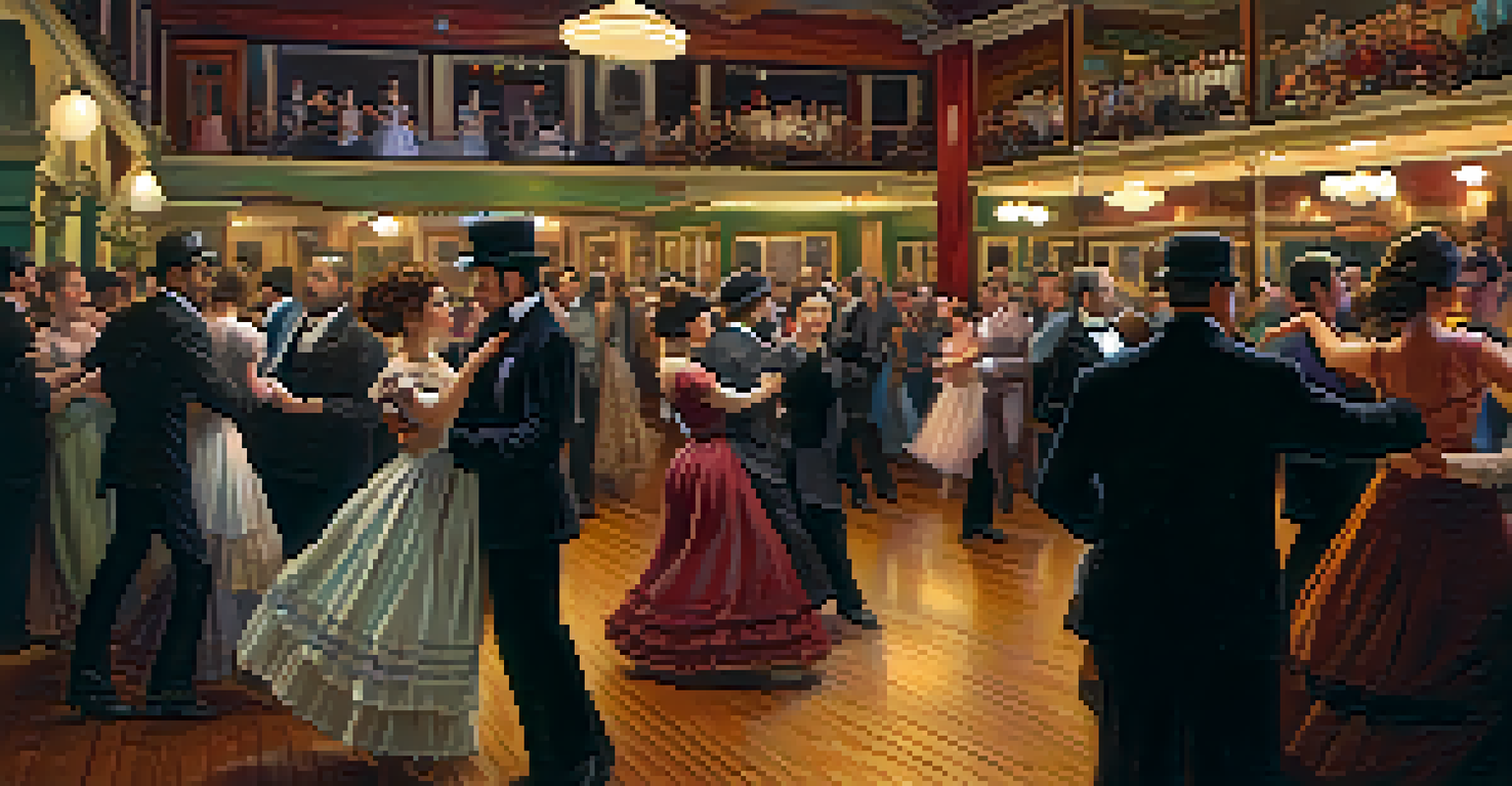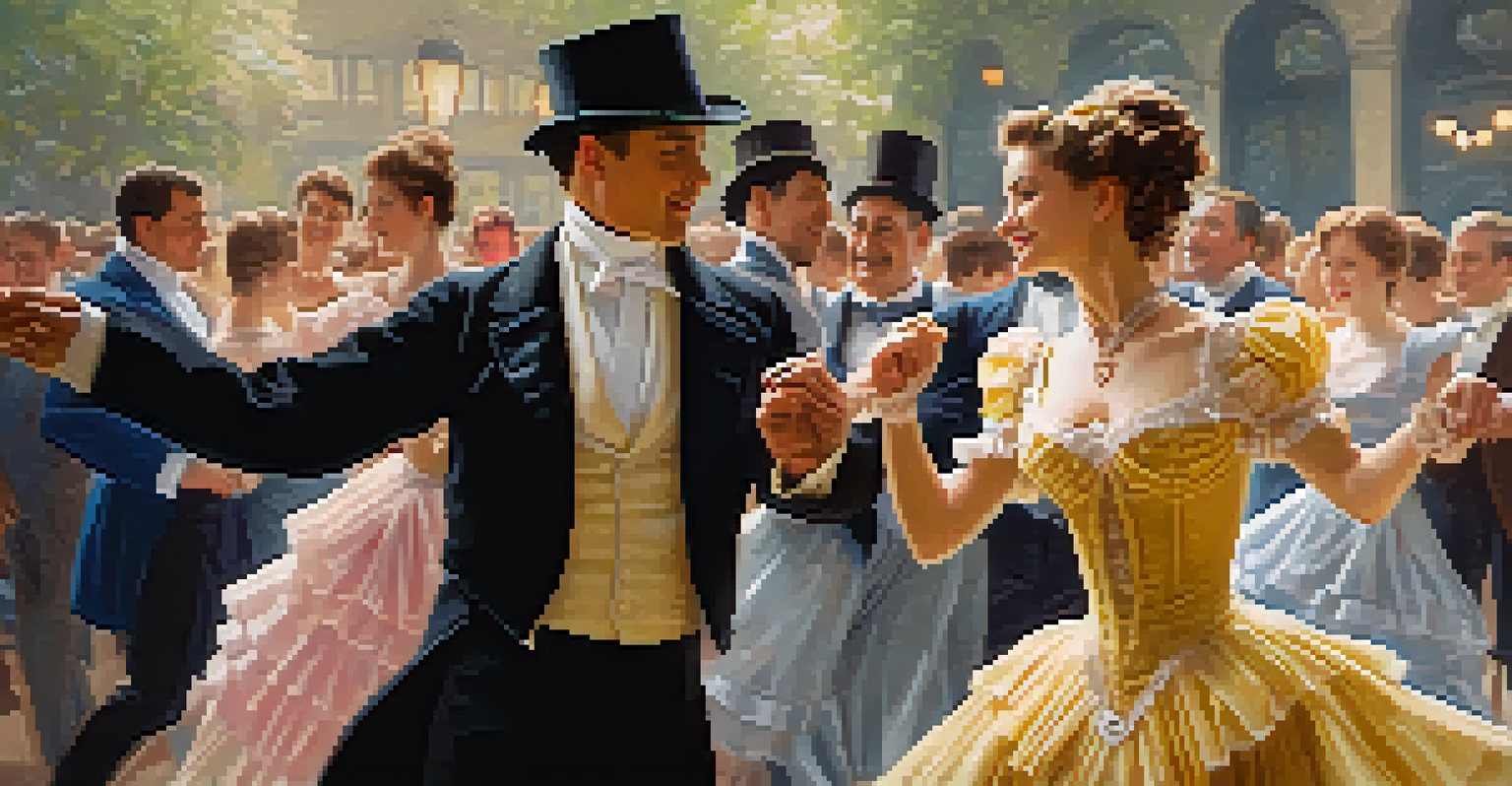The Transformation of Dance in the Victorian Era: A Social Lens

The Victorian Era: A Brief Overview of Social Context
The Victorian Era, spanning from 1837 to 1901, was a time of significant social transformation in Britain. This period was marked by rapid industrialization, urbanization, and a shifting cultural landscape. The emergence of a middle class began to alter social norms, including those surrounding entertainment and leisure activities. Dance, in particular, played a pivotal role in reflecting these societal changes as it evolved from a courtly activity to a more accessible form of expression for the masses.
Dance is the hidden language of the soul.
During this time, dance venues such as music halls and ballrooms became popular, providing spaces for both the affluent and the emerging middle class. Social gatherings, including balls and parties, began to incorporate various dance styles, highlighting the growing importance of social interaction through movement. The transformation of dance during this era wasn't just about the steps; it was also about the relationships and social dynamics that were unfolding in Victorian society.
As dance became a favored pastime, it also mirrored the complexities of Victorian values, including propriety and decorum. While some dances were considered elegant and refined, others challenged the era's strict social codes. This duality set the stage for a rich exploration of dance as both an art form and a social commentary.
The Rise of Social Dance: From Balls to Dance Halls
Social dance flourished in the Victorian Era, with balls becoming a staple of high society. These grand events were not just about entertainment; they were crucial for social networking and matchmaking. Young men and women would showcase their dancing skills, with the waltz and polka emerging as popular choices. Each dance had its own set of rules and etiquette, emphasizing the importance of decorum in these social settings.

As the industrial revolution progressed, dance halls began to sprout in urban areas, making dance more accessible to the working class. These venues became a melting pot of cultures and styles, allowing people from different backgrounds to come together and enjoy the joys of dance. The transition from formal balls to more casual dance halls marked a significant shift in social dynamics, as it broke down class barriers and fostered a sense of community.
Victorian Dance Reflected Society
Dance during the Victorian era mirrored significant social transformations, showcasing changing class dynamics and gender roles.
However, this accessibility also led to criticism from the upper classes, who often viewed the dance halls as chaotic and morally questionable. Despite this, the dance hall culture thrived, paving the way for new dance styles and reflecting the era's evolving attitudes towards social interaction and leisure.
Dance as a Reflection of Gender Roles
In the Victorian era, dance was often intertwined with the prevailing gender roles of the time. Women were typically expected to embody grace and modesty in their dancing, while men were seen as strong and assertive. This dynamic was evident in the choreography of popular dances, where men often led, while women followed. Such roles not only shaped the way dances were performed but also reinforced societal expectations regarding gender behavior.
Art is the most beautiful of all lies; it is the truth that has been transformed into beauty.
The emergence of dances like the waltz, which allowed for closer physical contact, stirred debates about propriety and the boundaries of male-female interaction. While some celebrated the intimacy of these dances as a new form of expression, others condemned them as inappropriate. This tension highlighted the struggle for women's autonomy within the confines of a strictly regulated society, where dancing could serve as both a means of liberation and a source of controversy.
As the Victorian Era progressed, women began to challenge these traditional roles, seeking more freedom in both dance and life. This shift was not just about the steps they took on the dance floor but also about the broader movement toward women's rights and independence. Dance became a subtle platform for expressing desires for change, allowing women to assert their identities and break away from societal constraints.
The Influence of Theatrical Dance and Performance
The Victorian era saw a rise in theatrical dance, which incorporated storytelling into performances. The fusion of dance with drama allowed for more expressive forms that captivated audiences and reflected societal narratives. This shift was evident in the popularity of productions like the ballet and variety shows, which combined music, dance, and storytelling to entertain and provoke thought.
Theatrical dance also created new opportunities for female performers, who began to gain recognition for their talents. As the boundaries between performer and audience blurred, women found a platform to express themselves creatively and challenge societal norms. The growing popularity of these performances showcased the evolving role of women in the arts, where they began to be seen as more than just passive participants.
Social Dance Fostered Community
The rise of dance halls made dance accessible to the working class, promoting a sense of community across diverse backgrounds.
However, this newfound visibility came with its own challenges, as performers navigated the fine line between respectability and scandal. The public's fascination with the sensational often overshadowed the artistry, leading to debates about morality and decency in dance. The theatrical scene became a battleground for discussions on women's roles in society, as well as the evolving nature of dance as a form of expression.
The Impact of Dance on Social Reform Movements
Dance in the Victorian era was not just about entertainment; it also played a role in social reform movements. Various dance forms began to be associated with causes such as women's rights and labor movements. For example, folk dances were often performed at rallies and events, symbolizing unity and collective identity among participants. These dances served as a vehicle for expressing shared values and aspirations.
As social movements gained momentum, dance became a means of protest and empowerment. Participants used the rhythm and movement of dance to rally for change, illustrating how this art form could transcend mere entertainment. The act of dancing together fostered a sense of community and solidarity among those advocating for social justice, highlighting the power of collective action.
Moreover, the visibility of dance in these movements drew attention to the underlying social issues of the era, such as poverty and inequality. By connecting dance with activism, reformers were able to engage a wider audience and inspire action. This interplay between dance and social reform enriched the cultural landscape and demonstrated how art can influence societal change.
The Legacy of Victorian Dance in Modern Society
The transformation of dance during the Victorian era laid the groundwork for contemporary dance styles and social practices. Many of the dances that gained popularity during this time have influenced modern ballroom dancing and other social dance forms. The emphasis on partnership and interaction remains a key element, showcasing how the past continues to resonate in our current cultural expressions.
Furthermore, the discussions surrounding gender roles and social etiquette in Victorian dance have evolved but continue to be relevant today. Modern dance has expanded to embrace diverse expressions of identity, allowing for a broader interpretation of movement and partnership. This evolution reflects the ongoing journey toward inclusivity and acceptance in dance and society at large.
Dance as a Tool for Social Reform
Dance played a vital role in social reform movements, serving as a means of protest and empowerment for various causes.
Additionally, the legacy of dance as a form of social commentary is still evident in various dance genres today, where artists often use movement to address contemporary issues. The Victorian era taught us that dance is not just a performance; it is a powerful medium for storytelling and social dialogue. As we continue to explore dance, we honor its historical roots and recognize its potential to inspire change.
Conclusion: Dance as a Social Mirror
In conclusion, the transformation of dance during the Victorian era serves as a fascinating lens through which we can examine social changes. From the rise of social dance to the influence of theatrical performance, each development reflected broader societal shifts and challenges. The era's dance culture not only entertained but also sparked conversations about gender, class, and social reform, highlighting its significance beyond the dance floor.
As we reflect on this rich history, it's essential to recognize that dance remains a dynamic form of expression, continually evolving with society. The lessons learned from the Victorian era remind us of the potential for dance to challenge norms and foster connection. Just as dancers of the past navigated their cultural landscape, contemporary dancers continue to shape their identities and communities through movement.

Ultimately, dance is a powerful social mirror, reflecting the values, struggles, and aspirations of its time. By appreciating the transformation of dance in the Victorian era, we gain insight into our own societal evolution and the role that art plays in shaping our understanding of ourselves and each other.